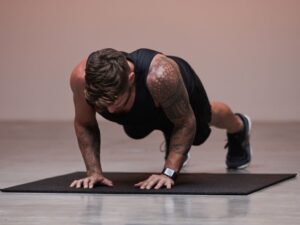Summary
- Bodyweight exercises effectively drive muscle hypertrophy by applying mechanical tension, metabolic stress, muscle damage, and progressive overload
- Progressions in bodyweight training, like archer push-ups or single-arm variants, increase mechanical tension for muscle growth.
Bodyweight training can drive meaningful hypertrophy when you apply the core principles of mechanical tension, metabolic stress, muscle damage, and progressive overload—just as in traditional resistance training. By choosing the right exercises and clever progressions, dialing in nutrition and recovery, and recognizing limitations (especially at advanced levels), you can sculpt and strengthen muscle with nothing but your own weight.
1. The Science of Muscle Growth
1.1 Mechanisms Behind Hypertrophy
At its core, muscle hypertrophy arises from three primary stimuli: mechanical tension, muscle damage, and metabolic stress. Mechanical tension—force generated by muscle fibers under load—appears to be the most critical driver of long-term growth. Muscle damage, the microtears from intense contractions, and metabolic stress—the “burn” from anaerobic work—also contribute by signaling cells to repair and thicken fibers.
1.2 Progressive Overload: The Cornerstone
No matter your gear—or lack thereof—muscles need gradually increasing demand to grow. Progressive overload simply means challenging your muscles harder over time, whether through added reps, slower tempo, or more difficult bodyweight variations. Without this principle, gains plateau.
2. Bodyweight Training and Mechanical Tension
2.1 Translating Tension with Only Bodyweight
Traditional weight training uses external loads to create tension, but bodyweight exercises can match that by manipulating leverage and exercise difficulty. For example, elevating feet in a push-up increases the force on your shoulders and chest; shifting into a single-arm variant further intensifies load on one side.
2.2 Exercise Selection
Some staple bodyweight moves pack a surprising punch:
- Push-ups (standard, decline, archer, one-arm): scalable by elevating feet or narrowing hand placement
- Pull-ups and chin-ups: arguably the gold standard for vertical pulling tension
- Pistol squats and Bulgarian split squats: unilateral lower-body work that rivals heavy back squats in tension
- Dips (bench, parallel-bar): intense loading of triceps, chest, and shoulders
Each of these can be dialed up—more reps, slower negatives, added isometric holds—to chase that tension threshold.
3. Progressive Overload Without Weights
3.1 Manipulating Variables
When there’s no dumbbell or barbell to add weight to, tweak:
- Repetition range: Push past traditional 8–12 into high-rep territory (15–30+), but only as a bridge—real hypertrophy thrives on moderate reps with tension.
- Tempo: Slow eccentrics (3–5 seconds lowering) spike time under tension.
- Range of motion: Elevating hands or feet shifts load, increasing tension at key angles.
- Altered leverage: Moving hands or feet closer to center, doing archer push-ups, suspended variations—each change can be as taxing as adding plates.
3.2 Progressive Calisthenics
Calisthenics athletes use skill progressions—L-sit to V-sit, tuck planche to full planche—to methodically increase load on target muscles. By chaining progressions, even world-class athletes remain in a growth stimulus.
4. Metabolic Stress and Muscle Damage in Bodyweight Work
4.1 The “Pump” Factor
High-rep clusters, supersets (push-up to dips), and circuit formats generate metabolic buildup—hydrogen ions, piking lactic acid—for that deep “pump” which research ties to growth signaling.
4.2 Strategic Muscle Damage
While you can’t swap plates for progression in every case, you can purposefully include eccentric-focused work—slow negative pull-ups, plyometric push-ups—to induce fiber microtrauma and subsequent repair-driven hypertrophy.
5. Programming Your Bodyweight Routine
5.1 Sample Weekly Split
- Day 1 – Push: Standard/decline push-ups, dips, pike push-ups, triceps extensions (inverted)
- Day 2 – Pull: Pull-ups, chin-ups, inverted rows, Australian pull-ups
- Day 3 – Legs/Core: Pistol squats, Bulgarian split squats, glute bridges, planks, hanging leg raises
- Day 4 – Rest or Active Recovery
- Day 5 – Hybrid Circuit: Mix push, pull, legs in a 4-round AMRAP (as many rounds as possible)
- Day 6 & 7 – Rest/Light Cardio
Vary set-rep schemes: heavy (4×5–8) on harder variations, moderate (3×10–15) on mid-range, and burnout (2×20–30) for metabolic stress. Adjust based on your progress.
5.2 Tracking Progress
Log reps, monitor how long you can hold isometrics, and note when a progression becomes “easy”—that’s your cue to move up a level or slow the tempo.
6. Nutrition and Recovery
6.1 Fuel for Growth
Adequate protein intake (1.6–2.2 g/kg body weight) remains non-negotiable for muscle protein synthesis. Carbs replenish glycogen for high-intensity calisthenics, while healthy fats support hormone levels.
6.2 Rest & Sleep
Muscle repair peaks during deep sleep; aim for 7–9 hours nightly. Overtraining in high-volume circuits without rest can stall gains and increase injury risk
7. Limitations and When to Introduce External Loads
7.1 Advanced Plateau
Beyond a certain strength threshold, purely bodyweight methods may fail to create sufficient tension—especially in lower-body moves where your leg strength can far exceed gravity’s resistance. Studies comparing bodyweight to barbell squats show greater hypertrophy and fat loss with weighted squats in trained individuals.
7.2 Injury Considerations
Pushing progressions without perfect form risks joint overload. When in doubt, regress—better to slow tempo or drop a progression than to power through pain.
Bringing It All Together
Yes—science confirms you can build significant muscle with nothing but your bodyweight, so long as you treat those push-ups and pull-ups like the heavy lifts they are. By understanding hypertrophy’s drivers, creatively manipulating exercise variables, prioritizing nutrition and recovery, and recognizing when to add weight, you’ll tap into calisthenics’ full potential. Whether you’re a beginner craving visible arm gains or an advanced athlete chasing lean, functional strength, bodyweight training—armed with the right strategy—can be your most flexible, accessible path to muscle.
Stay consistent, track progress, and let your own body inspire you to grow.









It’s impressive how bodyweight training can be so effective for muscle growth when combined with the right techniques and strategies. It’s a great reminder that you don’t always need access to a gym to make significant fitness gains. Keep pushing and exploring those creative exercise variations!